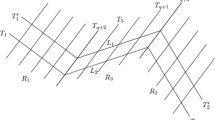Abstract.
We (1) determine the number of Latin rectangles with 11 columns and each possible number of rows, including the Latin squares of order 11, (2) answer some questions of Alter by showing that the number of reduced Latin squares of order n is divisible by f! where f is a particular integer close to \(\frac{1}{2}n,\) (3) provide a formula for the number of Latin squares in terms of permanents of (+1, −1)-matrices, (4) find the extremal values for the number of 1-factorisations of k-regular bipartite graphs on 2n vertices whenever 1 ≤ k ≤ n ≤ 11, (5) show that the proportion of Latin squares with a non-trivial symmetry group tends quickly to zero as the order increases.
Similar content being viewed by others
Author information
Authors and Affiliations
Corresponding author
Additional information
Received September 3, 2004
Rights and permissions
About this article
Cite this article
McKay, B.D., Wanless, I.M. On the Number of Latin Squares. Ann. Comb. 9, 335–344 (2005). https://doi.org/10.1007/s00026-005-0261-7
Issue Date:
DOI: https://doi.org/10.1007/s00026-005-0261-7



